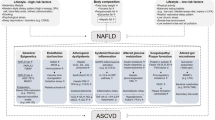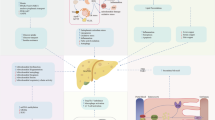Abstract
Insulin resistance may favor increased urinary albumin excretion (UAE), leading progressively to chronic kidney disease (CKD). A recent study on non-alcoholic fatty liver disease (NAFLD), a condition of insulin resistance, associated this disease with the incidence of CKD in patients with type 2 diabetes. The aim of our study was to determine whether there is an association between insulin resistance and kidney function, based on estimates of UAE and creatinine clearance in children with biopsy-proven NAFLD. Kidney function was assessed in 80 patients with NAFLD and 59 individuals of normal weight matched for age and sex. Insulin resistance was measured by means of the homeostatic model assessment-insulin resistance (HOMA-IR) and limited to NAFLD patients by using the whole-body insulin sensitivity index. The HOMA-IR was found to differ significantly between the two groups (2.69 ± 1.7 vs. 1.05 ± 0.45; p = 0.002), while UAE (9.02 ± 5.8 vs. 8.0 ± 4.3 mg/24 h; p = 0.9) and creatinine clearance (78 ± 24 vs. 80 ± 29 mg/min; p = 0.8) did not. We found a significant but weak inverse correlation between insulin sensitivity and creatinine clearance in NAFLD patients (r s = –0.25;p = 0.02). No difference was observed in kidney function between NAFLD children presenting with or without metabolic syndrome, low or normal HDL-cholesterol, and different degrees of histological liver damage (grade of steatosis ≥2, necro-inflammation, and fibrosis). Patients with hypertension had increased levels of UAE (p = 0.04). A longer exposure to insulin resistance may be required to cause the increase in urinary albumin excretion and to enable the detection of the effect of the accelerated atherogenic process most likely occurring in children with fatty liver disease. Longitudinal studies are needed to rule out any causative relationship between insulin resistance and urinary albumin excretion.
Similar content being viewed by others
References
Borch-Johnsen K, Feldt-Rasmussen B, Strandgaard S, Schroll M, Jensen JS (1999) Urinary albumin excretion. An independent predictor of ischemic heart disease. Arterioscler Thromb Vasc Biol 19:1992–1997
Hillege HL, Fidler V, Diercks GF, van Gilst WH, de Zeeuw D, van Veldhuisen DJ, Gans RO, Janssen WM, Grobbee DE, de Jong PE; Prevention of Renal and Vascular End Stage Disease (PREVEND) Study Group (2002) Urinary albumin excretion predicts cardiovascular and noncardiovascular mortality in general population. Circulation 106:1777–1782
Gerstein HC, Mann JF, Yi Q, Zinman B, Dinneen SF, Hoogwerf B, Hallé JP, Young J, Rashkow A, Joyce C, Nawaz S, Yusuf S, HOPE Study Investigators (2001) Albuminuria and risk of cardiovascular events, death, and heart failure in diabetic and nondiabetic individuals. JAMA 286:421–426
Wachtell K, Ibsen H, Olsen MH, Borch-Johnsen K, Lindholm LH, Mogensen CE, Dahlöf B, Devereux RB, Beevers G, de Faire U, Fyhrquist F, Julius S, Kjeldsen SE, Kristianson K, Lederballe-Pedersen O, Nieminen MS, Okin PM, Omvik P, Oparil S, Wedel H, Snapinn SM, Aurup P (2003) Albuminuria and cardiovascular risk in hypertensive patients with left ventricular hypertrophy: the LIFE study. Ann Intern Med 139:901–906
Klausen K, Borch-Johnsen K, Feldt-Rasmussen B, Jensen G, Clausen P, Scharling H, Appleyard M, Jensen JS (2004) Very low levels of microalbuminuria are associated with increased risk of coronary heart disease and death independently of renal function, hypertension, and diabetes. Circulation 110:32–35
Forman JP, Brenner BM (2006) ‘Hypertension’ and ‘microalbuminuria’: the bell tolls for thee. Kidney Int 69:22–28
Orchard TJ, Chang YF, Ferrell RE, Petro N, Ellis DE (2002) Nephropathy in type 1 diabetes: a manifestation of insulin resistance and multiple genetic susceptibilities? Further evidence from the Pittsburgh Epidemiology of Diabetes Complication Study. Kidney Int 62:963–970
Mykkänen L, Zaccaro DJ, Wagenknecht LE, Robbins DC, Gabriel M, Haffner SM (1998) Microalbuminuria is associated with insulin resistance in nondiabetic subjects: the insulin resistance atherosclerosis study. Diabetes 47:793–800
Parvanova AI, Trevisan R, Iliev IP, Dimitrov BD, Vedovato M, Tiengo A, Remuzzi G, Ruggenenti P (2006) Insulin resistance and microalbuminuria: a cross-sectional, case–control study of 158 patients with type 2 diabetes and different degrees of urinary albumin excretion. Diabetes 55:1456–1462
Ruggenenti P, Remuzzi G (2006) Time to abandon microalbuminuria. Kidney Int 70:1214–1222
Manco M, Marcellini M, Devito R, Comparcola D, Sartorelli MR, Nobili V (2008) Metabolic syndrome and liver histology in paediatric non-alcoholic steatohepatitis. Int J Obes (Lond) 32:381–387
World Health Organization (1999) Report of a WHO consultation: definition, diagnosis, and classification of diabetes mellitus and its complications. Part 1: Diagnosis and classification of diabetes mellitus. Department of Noncommunicable Disease Surveillance, WHO, Geneva
Targher G, Chonchol M, Bertolini L, Rodella S, Zenari L, Lippi G, Franchini M, Zoppini G, Muggeo M (2008) Increased risk of CKD among type 2 diabetics with nonalcoholic fatty liver disease. J Am Soc Nephrol 19:1564–1570
Manco M, Bedogni G, Marcellini M, Devito R, Ciampalini P, Sartorelli MR, Comparcola D, Piemonte F, Nobili V (2008) Waist circumference correlates with liver fibrosis in children with non-alcoholic steatohepatitis. Gut 57:1283–1287
Cole TJ, Bellizzi MC, Flegal KM, Dietz WH (2000) Establishing a standard definition for child overweight and obesity worldwide: International survey. BMJ 320:1–6
Alberti G, Zimmet P (2007) The IDF consensus on the prevention of Type 2 Diabetes. Diabetes Voice 52:23–27
National High Blood Pressure Education Program Working Group on High Blood Pressure in Children and Adolescents (2004) The fourth report on the diagnosis, evaluation, and treatment of high blood pressure in children and adolescents. Pediatrics 114:555–576
Italian Society of Pediatrics (2006) Obesità del bambino e dell’adolescente: Consensus su prevenzione, diagnosi e terapia. Available at https://doi.org/www.scottibassani.it
Expert Committee on the Diagnosis and Classification of Diabetes Mellitus (2003) Report of the Expert Committee on the Diagnosis and Classification of Diabetes Mellitus. Diabetes Care 26:S5–20
Matthews DR, Hosker JP, Rudenski AS, Naylor BA, Treacher DF, Turner RC (1985) Homeostasis model assessment: insulin resistance and beta-cell function from fasting plasma glucose and insulin concentrations in man. Diabetologia 28:412–419
Matsuda M, DeFronzo RA (1999) Insulin sensitivity indices obtained from oral glucose tolerance testing: comparison with the euglycemic insulin clamp. Diabetes Care 22:1462–1470
Kleiner DE, Brunt EM, Van Natta M, Behling C, Contos MJ, Cummings OW, Ferrell LD, Liu YC, Torbenson MS, Unalp-Arida A, Yeh M, McCullough AJ, Sanyal AJ; Nonalcoholic Steatohepatitis Clinical Research Network (2005) Design and validation of a histological scoring system for non alcoholic fatty liver disease. Hepatology 41:1313–1321
Keskin M, Kurtoglu S, Kendirci M, Atabek ME, Yazici C (2005) Homeostasis model assessment is more reliable than the fasting glucose/insulin ratio and quantitative insulin sensitivity check index for assessing insulin resistance among obese children and adolescents. Pediatrics 115:e500–e503
Jasik CB, Lustig RH (2008) Adolescent obesity and puberty: the “perfect storm”. Ann N Y Acad Sci 1135:265–279
Deckert T, Feldt-Rasmussen B, Borch-Johnsen K, Jensen T, Kofoed-Enevoldsen A (1989) Albuminuria reflects widespread vascular damage. The Steno hypothesis. Diabetologia 32:219–226
Dahlquist G, Rudberg S (1987) The prevalence of microalbuminuria in diabetic children and adolescents and its relation to puberty. Acta Paediatr Scand 76:795–800
Bangstad HJ, Dahl-Jorgensen K, Kjaersgaard P, Mevold K, Hanssen KF (1993) Urinary albumin excretion rate and puberty in non-diabetic children and adolescents. Acta Paediatr 82:857–862
Mueller PW, Caudill SP (1999) Urinary albumin excretion in children: factors related to elevated excretion in the United States population. Ren Fail 21:293–302
Nguyen S, McCulloch C, Brakeman P, Portale A, Hsu C (2008) Being overweight modifies the association between cardiovascular risk factors and microalbuminuria in adolescents. Pediatrics 121:37–45
Mathiesen ER, Saurbrey N, Hommel E, Parving HH (1986) Prevalence of microalbuminuria in children with type 1 (insulin-dependent) diabetes mellitus. Diabetologia 29:640–643
Burgert TS, Dziura J, Yeckel C, Parving HH (2005) Microalbuminuria in pediatric obesity: prevalence and relation to other cardiovascular risk factors. Int J Obes (Lond) 30:273–280
Csernus K, Lanyi E, Erhardt E, Molnar D (2005) Effect of childhood obesity and obesity-related cardiovascular risk factors on glomerular and tubular protein excretion. Eur J Pediatr 164:44–49
Maahs DM, Snively BM, Bell RA, Dolan L, Hirsch I, Imperatore G, Linder B, Marcovina SM, Mayer-Davis EJ, Pettitt DJ, Rodriguez BL, Dabelea D (2007) The SEARCH for Diabetes in Youth Study: higher prevalence of elevated albumin excretion in youth with type 2 than type 1 diabetes. Diabetes Care 30:2593–2598
Ettinger LM, Freeman K, DiMartino-Nardi JR, Flynn JT (2005) Microalbuminuria and abnormal ambulatory blood pressure in adolescents with type 2 diabetes mellitus. J Pediatr 147:67–73
Eppens MC, Craig ME, Cusumano J, Hing S, Chan AK, Howard NJ, Silink M, Donaghue KC (2004) Prevalence of diabetes complications in adolescents with type 2 compared with type 1 diabetes. Diabetes Care 29:1300–1306
Yoo EG, Choi IK, Kim DH (2004) Prevalence of microalbuminuria in young patients with type 1 and type 2 diabetes mellitus. J Pediatr Endocrinol Metab 17:1423–1427
Adelman RD, Restaino IG, Alon US, Blowey DL (2001) Proteinuria and focal segmental glomerulosclerosis in severely obese adolescents. J Pediatr 138:481–485
Author information
Authors and Affiliations
Corresponding author
Rights and permissions
About this article
Cite this article
Manco, M., Ciampalini, P., DeVito, R. et al. Albuminuria and insulin resistance in children with biopsy proven non-alcoholic fatty liver disease. Pediatr Nephrol 24, 1211–1217 (2009). https://doi.org/10.1007/s00467-009-1134-9
Received:
Revised:
Accepted:
Published:
Issue Date:
DOI: https://doi.org/10.1007/s00467-009-1134-9




